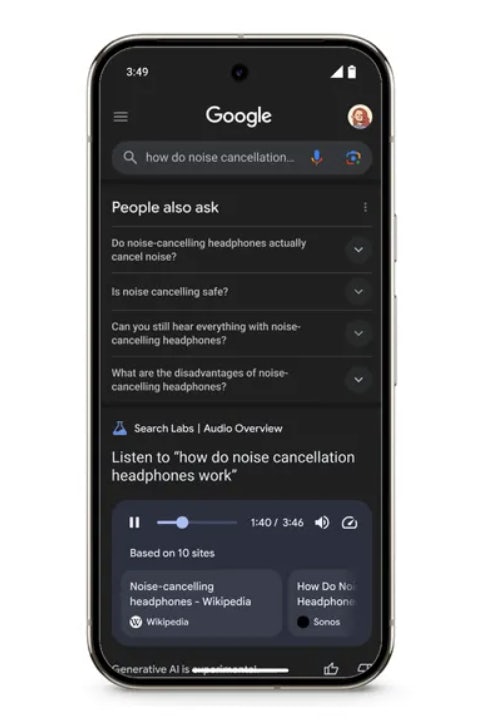The largest changes influencing the SERP landscape are examined in this month’s search roundup. From a range of new AI Overview tests and AI Mode, to practical updates on Google’s documentation, we’ll discuss it all below.
Google AI Mode has officially launched in India, marking its first international expansion beyond the US, where it was initially introduced in March 2025. This experimental feature within Search Labs offers users a more AI-like interface, particularly for complex search queries. Google’s CEO has also announced that AI mode will eventually integrate into main search.
In other news, Google has been testing further changes for AI and Audio Overviews. The new Audio Overviews provide AI-generated spoken summaries to offer a hands-free way to understand topics. AI Overviews have been appearing unusually at the bottom of search results pages.
Allow our traffic light system to guide you to the articles that need your attention, so watch out for Red light updates as they’re major changes that will need you to take action, whereas amber updates may make you think and are definitely worth knowing, but aren’t urgent. And finally, green light updates, which are great for your SEO and site knowledge, but are less significant than others.
Keen to know more about any of these changes and what they mean for your SEO? Get in touch or visit our SEO agency page to find out how we can help.
- Google AI mode is now available in India
- Google CEO confirms plans to eventually integrate AI Mode into main search
- Google updates URL structure documentation
- Google is testing Audio Overviews for Search results
- What do the Audio Overviews look like?
- Google is testing AI Overviews at the bottom of the search results page
Back in March, we reported on the announcement of the new Google AI mode. Initially rolled out in the US, it now appears that Google has expanded AI mode outside of the US for the first time, and is now being rolled out in India.
It has been rolled out as an experimental feature in Labs in English, allowing Google to build on positive feedback regarding its speed, quality, and responsiveness from US users. Google envisions AI Mode as the future of Search, with plans for continued global rollout and eventual widespread availability outside of Search Labs, urging users and businesses to explore its potential impact on online presence and search strategies.
Google CEO Sundar Pichai‘s confirmation that AI Mode will eventually be integrated into the main Google Search experience, coupled with its appearance in People Also Ask (PAA) and Chrome suggestion boxes, signals a significant and inevitable shift in how users will interact with search.
By putting AI Mode answers directly into PAA and omnibox suggestions, Google is making AI-generated information instantly accessible. Users won’t have to navigate to a separate AI Mode tab or consciously choose an AI-driven experience, making AI a more natural and seamless part of the typical search journey. Instead of being a distinct feature, it becomes an embedded layer of intelligence within the existing search interface.
However, this will amplify the trend of users getting answers directly on the SERP without clicking through to websites. This puts even more pressure on publishers to differentiate their content and provide value beyond readily summarised information.
For content to be chosen and cited by Google’s AI models, its Experience, Expertise, Authoritativeness, and Trustworthiness (E-E-A-T) signals will be more critical than ever.
Google has indeed updated its URL structure documentation within Search Central. The primary focus of this update is to improve the clarity, organisation, and practicality of the information provided to webmasters and SEOs.
The document has been restructured to have a more logical flow, making it easier for users to find the information they need. A key improvement is the inclusion of numerous “Recommended” vs. “Not recommended” examples presented in tabular format. These examples are based on real-world URLs Google has encountered, making the advice more tangible and actionable. This helps users quickly grasp the correct implementation.
Read our guide, Essential Guide to URL Parameters, to apply the best practice for identical versions of the same web resource.
Google is experimenting with a new feature called “Audio Overviews” for its search results, designed to provide AI-generated spoken summaries. This innovative tool, available to US users through Google’s Search Labs, leverages the Gemini AI model to create concise, conversational audio clips that synthesise information from search queries. The primary goal is to offer a hands-free way for users to quickly grasp a topic, particularly when they are unfamiliar with it.
What do the Audio Overviews look like?
When enabled, users may see a prompt to generate an audio summary, which then plays directly within the search results page via a mini-player. Google also includes links to related webpages below the audio summary for those who wish to delve deeper. This initiative reflects Google’s ongoing commitment to making Search more multimodal and accessible, catering to diverse user preferences. Here’s what the Audio Overviews look like:

After typically seeing AI Overviews at the top of the search results page as well as sometimes in the middle, Google has now been seen testing displaying them at the bottom. While some users might prefer this, the unusual positioning has been thought to be a bug, rather than a deliberate strategy, given it could potentially increase traffic back to publishers.
The unusual placement has led to discussions questioning the types of queries that might trigger such an AI Overview position. It has been suggested that this might occur for very local or straightforward queries that do not necessitate extensive, in-depth explanations at the top of the search results.
Keep up-to-date with our dedicated algorithm and search industry round-ups. For any further information about these posts, or to learn how we can support your SEO, get in touch today.








